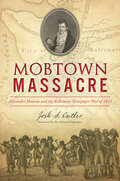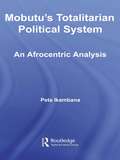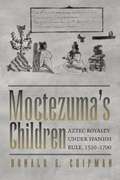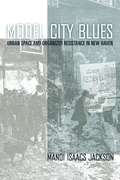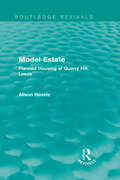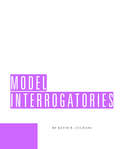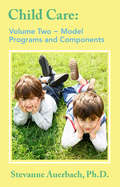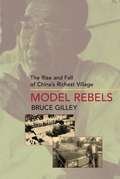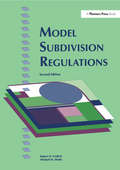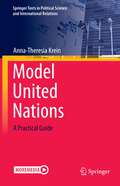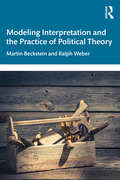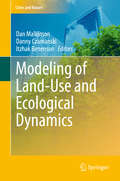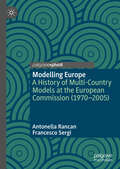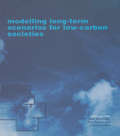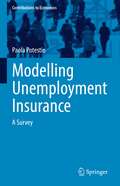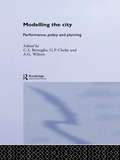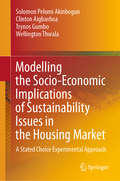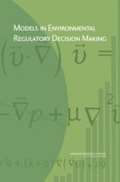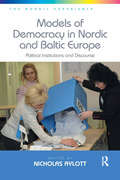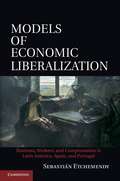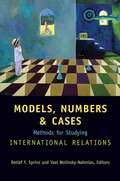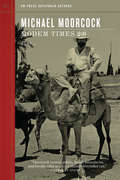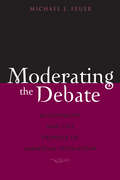- Table View
- List View
Mobtown Massacre: Alexander Hanson and the Baltimore Newspaper War of 1812 (True Crime)
by Josh S. CutlerWinner of the 2020 Baltimore History Prize, this is a gripping account of how a Federalist editor risked his life to defend his anti-war views. With a bitterly divided nation plunged into the War of 1812, Alexander Hanson penned an anti-war editorial that provoked a violent standoff that crippled the city of Baltimore and left Hanson beaten within an inch of his life. This little-known episode in American history—complete with a midnight jailbreak, bloodthirsty mobs and unspeakable acts of torture—helped shape the course of war, the Federalist Party and the nation&’s very notion of the freedom of the press. Josh Cutler&’s history of the Mobtown Massacre offers a lesson in liberty that reverberates today. &“A compelling story that&’s as timely today as it was two centuries ago.&” —Congressman William R. Keating &“A remarkably vivid, engaging and very readable account of a brief but major event in Baltimore history . . . which reflected the sharp political divisiveness of the time at the start of the War of 1812, and had important implications for freedom of the press and the war itself.&”—Charles Markell, board member, Baltimore City Historical Society &“A timely and scholarly examination of one man&’s struggle for freedom of the press.&”—Fred Dorsey, Howard County, MD historian &“Cutler&’s book tells not only of politics of that era and the controversy of a war that ultimately led to the burning of the White House and the writing of &‘The Star-Spangled Banner&’ by Francis Scott Key, but also how it challenged America&’s devotion to a free press.&” —The Baltimore Sun
Mobutu's Totalitarian Political System: An Afrocentric Analysis (African Studies)
by Jean-Louis Peta IkambanaMobutu's political system, inaugurated in 1965 and lasting more than three decades, met all the characteristics of totalitarianism. This study shows that the failures and misdeeds of Mobutu's system were clear evidence that it lacked an African-centred vision and did not put the interests of the African people of Congo (formerly Zaire) at the centre of this political project. In this study Mobutu's political actions in the 1990s - mostly as they related to the National Sovereign Conference - are critically analyzed and found to be a deliberate attempt to obstruct the momentum of democracy for the African people of Congo. From an Afro centric standpoint, this obstruction is evidence of Mobutu's attempt to impede the search for harmony and peace by the Zairian people, and to reject the African-centred truth that without Ma'at (harmony) there is no understanding and no possible restoration of balance. Mobutu's Totalitarian Political System will be of interest to students and scholars of ethnic studies, political science and international relations.
Moctezuma's Children: Aztec Royalty under Spanish Rule, 1520-1700
by Donald E. ChipmanThough the Aztec Empire fell to Spain in 1521, three principal heirs of the last emperor, Moctezuma II, survived the conquest and were later acknowledged by the Spanish victors as reyes naturales (natural kings or monarchs) who possessed certain inalienable rights as Indian royalty. For their part, the descendants of Moctezuma II used Spanish law and customs to maintain and enhance their status throughout the colonial period, achieving titles of knighthood and nobility in Mexico and Spain. So respected were they that a Moctezuma descendant by marriage became Viceroy of New Spain (colonial Mexico's highest governmental office) in 1696.
Model City Blues: Urban Space and Organized Resistance in New Haven
by Mandi Isaacs JacksonModel City Blues tells the story of how regular people, facing a changing city landscape, fought for their own model of the "ideal city" by creating grassroots plans for urban renewal. Filled with vivid descriptions of significant moments in a protracted struggle, it offers a street-level account of organized resistance to institutional plans to transform New Haven, Connecticut in the 1960s. Anchored in the physical spaces and political struggles of the city, it brings back to center stage the individuals and groups who demanded that their voices be heard. By reexamining the converging class- and race-based movements of 1960s New Haven, Mandi Jackson helps to explain the city's present-day economic and political struggles. More broadly, by closely analyzing particular sites of resistance in New Haven, Model City Blues employs multiple academic disciplines to redefine and reimagine the roles of everyday city spaces in building social movements and creating urban landscapes.
Model Estate: Planned Housing at Quarry Hill, Leeds (Routledge Revivals)
by Alison RavetzQuarry Hill Flats, once both the pride and shame of its city of Leeds, was an iconic Modernist symbol of the 1930s. It marked the first use of a prefabricated building system for a large-scale council estate, replacing a notorious slum. But it lasted barely a generation – its complete demolition was announced as Alison Ravetz was finishing this study. First published in 1974, this book is unique in its use of all estate records from conception to destruction, as well as in its comprehensive approach, including aspects usually missing in council housing studies – notably the intimate experience of residents, and a fraught, long-drawn-out building period. Ravetz argues that the Flats’ ‘failure’ was due not to social breakdown, as repeatedly alleged, but rather to a rigidity of design and management unable to accommodate gradual, incremental change. This has continuing implications for the operation of bureaucratically designed and controlled ‘social housing’ today.
Model Immigrants and Undesirable Aliens: The Cost of Immigration Reform in the 1990s
by Christina GerkenDuring 1995 and 1996, President Bill Clinton signed into law three bills that altered the rights and responsibilities of immigrants: the Antiterrorism and Effective Death Penalty Act, the Personal Responsibility Act, and the Illegal Immigration Reform and Immigrant Responsibility Act. Model Immigrants and Undesirable Aliens examines the changing debates around immigration that preceded and followed the passage of landmark legislation by the U.S. Congress in the mid-1990s, arguing that it represented a new, neoliberal way of thinking and talking about immigration. Christina Gerken explores the content and the social implications of the deliberations that surrounded the development and passage of immigration reform, analyzing a wide array of writings from congressional debates and committee reports to articles and human-interest stories in mainstream newspapers. The process, she shows, disguised its underlying racism by creating discursive strategies that shaped and upheld an image of &“desirable&” immigrants—those who could demonstrate &“personal responsibility&” and an ability to contribute to the U.S. economy. Gerken finds that politicians linked immigration to complex issues: poverty, welfare reform, so-called family values, measures designed to combat terrorism, and the spiraling costs of social welfare programs. Although immigrants were often at the center of congressional debates, politicians constructed an elaborate, abstract terminology that appeared to be unrelated to race or gender. Instead, politicians promoted neoliberal policies as the avenue to a postracist, postsexist world of opportunity for every rational consumer with an entrepreneurial spirit. Still, Gerken concludes that the passage of pathbreaking legislation was characterized by a useful tension between neoliberal assumptions and hidden anxieties about race, class, gender, and sexuality.
Model Interrogatories
by Kevin CulhaneModel Interrogatories Writing custom interrogatories can be one of the most critical aspects of your discovery plan. Asking the right questions in the proper format is the key to getting complete responses and avoiding nagging objections. Model Interrogatories is a comprehensive set of pre-drafted questions covering a variety of substantive areas that will help you quickly zero in on the most critical issues in every case. Here are 7 reasons to try the book: 1. Saves time--Customizing pre-drafted questions can save you hours. 2. Covers 26 different types of cases--These interrogatories tackle the tough legal issues that arise in a variety of cases. 3. Better answers--Each stand-alone interrogatory is direct, clear, and goes straight to the heart of the information critical to your case. You'll elicit more complete answers, avoid objections, and reduce the number of non-responsive answers. 4. More efficient discovery--You'll acquire more information with less effort and expense by using these interrogatories to guide your format and substantive coverage. 5. Digital access--Speed up production by inserting selected questions directly into your discovery. 6. Better utilize your staff--The book is so easy to use, your staff can prepare comprehensive discovery with relatively minor supervision. 7. Improve your standard interrogatories--Use the clearly phrased questions and definitions to supplement interrogatory sets you use repeatedly.
Model Programs and Their Components
by James A Rivaldo Ph.D. Stevanne AuerbachModel Programs and Components focuses on the planning and implementation of model programs and presents necessary steps to achieve a comprehensive and practical service to the community including health, food, social, and psychological services and documents local experiences in Appalachia, California, Colorado and Oregon. Foreword by Congressman John Brademas, former President of New York University. Contributors include James A. Levine, Helen L. Gordon, Jean H. Berman, Kathleen B. Latham, Kay Martin, Mary Millman, Mary W.Vlack, Ramon D. Blatt, Paul T. Barnes, Dr. Ann De Huff Peters, Dr. Susan S Aronson, Marilyn Chow, Dorothy N. Shack, David Brown, Keith R. Alward, Linda Regele-Sinclair, Christoph M, Heinicke, Dr. David Friedman, Dr. Elizabeth Prescott, Conchita Puncel, and June Solnit Sale.
Model Rebels: The Rise and Fall of China's Richest Village
by Bruce GilleyThis narrative about rural life and development in post-Mao China which also engages a scholarly political science debate about the reasons for political resistance.
Model Subdivision Regulations
by Robert H. Freilich Michael M. ShultzA major revision of a classic planning text. This book contains a complete model subdivision ordinance for city and county governments as well as more than 100 pages of legal commentary. The model regulations are generally compatible with all state statutes and work in urban, suburban, and rural settings. They show how communities can finance capital facilities, balance new development with existing surroundings, avoid exposure to the legal pitfalls of takings and substantive due process claims, and much more. Two new chapters cover public facilities impact fees and land readjustment. The chapter on impact fees includes a section on regulatory takings law that looks at how prominent U.S. Supreme Court cases have affected property rights, development, and regulation. Each section of the model regulations is followed by insightful commentary that supports, annotates, and documents the text. The authors explore the rationale for using various regulations, basing their arguments on existing statutory authority, case law, and federal constitutional requirements. The commentary identifies and explains changes from the original model regulations. Whether you're drafting new regulations or considering amendments to existing ones, you'll find Model Subdivision Regulations to be an invaluable reference.
Model United Nations: A Practical Guide (Springer Texts in Political Science and International Relations)
by Anna-Theresia KreinThis textbook presents a detailed insight into the structures and processes of preparing students for Model United Nations (MUN) conferences and for attending Model United Nations conferences, subsequently. It serves as a handbook and practical guide for the implementation of MUN into courses and classes in educational institutions.Written by a Faculty Advisor, and offering additional insights from an experienced award-winning MUN delegate, the book provides a particularly exceptional insightful, and well-rounded approach. The author explains how a MUN course can be taught, presents exercises to prepare students for the conference, and discusses how the MUN delegation and trip to the conference can be organized. This comprehensive guide offers insights into a broad range of topics, including debates with peers, diplomacy to solve international crises, and learning about the system of the United Nations (UN) organization through simulation. Further, it covers the development of soft skills and communication at the conferences and building international friendships, while it additionally allows learning more about the UN Sustainable Development Goals (SDGs) in the process.With tips, tricks, and bonus material this book will serve as an anchor throughout the students' first MUN experience, as well as provide valuable help for more advanced participants. The book, therefore, is a must-read for both academic staff teaching MUN, as well as students attending MUN courses and planning to attend MUN conferences.
Modeling Interpretation and the Practice of Political Theory
by Ralph Weber Martin BecksteinPolitical theory offers a great variety of interpretive traditions and models. Today, pluralism is the paradigm. But are all approaches equally useful? What are their limits and possibilities? Can we practice them in isolation, or can we combine them? Modeling Interpretation and the Practice of Political Theory addresses these questions in a refreshing and hands- on manner. It not only models in the abstract, but also tests in practice eight basic schemes of interpretation with which any ambitious reader of political texts should already be familiar. Comprehensive and engaging, the book includes: A straightforward typology of interpretation in political theory. Chapters on the analytical Oxford model, biographical and oeuvre- based interpretation, Skinner’s Cambridge School, the esoteric model, reflexive hermeneutics, reception analysis and conceptual history. Original readings of Federalist Paper No. 10 , Plato’s Statesman, de Gouges’s The Three Urns, Rivera’s wall painting The History of Mexico and Strauss’s Persecution and the Art of Writing; with further chapters on Machiavelli, Huang Zongxi and a Hittite loyalty oath. An Epilogue proposing pragmatist eclecticism as the way forward in interpretation. An inspiring, hands- on textbook suitable for undergraduate and graduate students, as well as experienced scholars of political theory, intellectual history and philosophy interested in learning more about types and models of interpretation, and the challenge of combining them in interpretive practice.
Modeling of Land-Use and Ecological Dynamics
by Dan Malkinson Danny Czamanski Itzhak BenensonAs cities are rapidly expanding and encroaching into agricultural and natural areas, a question of primary concern is how this expansion affects surrounding agriculture and natural landscapes. This book presents a wide spectrum of both theoretical and empirical approaches to simulation and assessment of landscape dynamics. The first part presents state-of-the-art modelling approaches pertaining to land-use changes entailed by the urban sprawl, at different spatial resolutions and temporal time scales. The second part is dedicated to case studies of the effects and consequences of the emerging urban-agriculture open space patterns.
Modelling Europe: A History of Multi-Country Models at the European Commission (1970-2005)
by Antonella Rancan Francesco SergiWhat was the role of economists and economics in the making of the European Union? This book sheds light on the activities of a particular type of economic experts: the macroeconomic modellers of the Directorate General for Economic and Financial Affairs (DG II), who built multi-country macroeconomic models of the European Economic Community. These models aim at studying the macroeconomic interactions between national economies and at providing insights about the effects of coordinating (or not) national economic policies. The book documents the origins, challenges, and progress made by DG II’s experts through building these models. This book provides insight into the influence of multi-country models on modern economics. It will be relevant to students and researchers interested in the history of economic thought and the development of macroeconomic policy.
Modelling Long-term Scenarios for Low Carbon Societies
by Junichi Fujino Neil Strachan Tim FoxonWith the ever-increasing impacts of climate change, it is now clear that global society will have to restructure its energy systems in order to decrease carbon emissions. The scenarios under which this transition to low-carbon societies (LCS) could occur would have complex economic, technological, behavioural and policy implications. This volume, a supplement to the Climate Policy journal, considers these implications by examining different low-carbon scenarios for different countries, modelled at different scales and typologies. Two overview chapters, co-written by international experts, set the context of scenario development and quantification of LCS, and summarize the findings on the economic implications, societal responses, technological developments and required policy measures to enable LCS across a range of countries. Further chapters detail the modelling of various scenarios and outline the model methodology, detail the economic and technological consequences of transitions to LCS, and comment on the strengths and weaknesses of specific policies.
Modelling Unemployment Insurance: A Survey (Contributions to Economics)
by Paola PotestioThis book examines unemployment insurance policy through a survey, taking stock of the theoretical work in the field of labor economics. It closely follows and assesses developments in the modelling of optimal unemployment insurance (UI) policies, beginning with the initial analytical findings produced in the second half of the 1970s. A main part of the survey is devoted to the two basic strands of analysis about, respectively, the optimal level of UI benefits and the optimal time profile of UI policy. The book has two different objectives. The first is to provide an essential summary of the individual models, with the intention of underscoring how a number of specific messages for the policy-maker can be derived from analytical constructions. It further emphasizes and comments on what the models deliver to UI policy-makers. The second objective is to stress the importance and extension of open questions in the field of the theoretical approach to the unemployment insurance issue. The survey discusses the multiplicity of heterogeneities of the labor world in particular as relevant for UI issues on the one side, and on the other hand, the independence of the two basic choices of UI policy, its meaning and its limits, and the possible forms of complementarity between these choices.The book is a must-read for researchers, students, and policy-makers interested in a better understanding of the field of labor economics in general, as well as unemployment insurance policies in particular.
Modelling the City: Performance, Policy and Planning
by C. S. Bertuglia G. R. Clarke A. G. WilsonFirst published in 1994. Routledge is an imprint of Taylor & Francis, an informa company.
Modelling the Socio-Economic Implications of Sustainability Issues in the Housing Market: A Stated Choice Experimental Approach
by Clinton Aigbavboa Wellington Thwala Solomon Pelumi Akinbogun Trynos GumboThis book discusses sustainable housing issues in urban areas throughout the Global South, revealing their complexity in terms of urban dynamics, housing markets and human interactions with the environment. Its main focus is on the location of graves within private residences, cemeteries in the immediate vicinity of private residences, and the implications of these factors for renters’ choices and rents. The book addresses the economics of land use for graves in connection with housing choices and the implications for the rented sector of the property market. By means of several model-based simulations, it demonstrates that the neoclassical economics remedy to the negative externality of graves in or near private residences remains generally unacceptable. Providing readers with a clear understanding of tenants’ priorities in their choice of housing, as well as a new approach to the negative externality of graves in the rented sector, the book will be of interest to policymakers, urban planners, investors in residential housing and land economists alike.
Models in Environmental Regulatory Decision Making
by National Research Council of the National AcademiesMany regulations issued by the U.S. Environmental Protection Agency (EPA) are based on the results of computer models. Models help EPA explain environmental phenomena in settings where direct observations are limited or unavailable, and anticipate the effects of agency policies on the environment, human health and the economy. Given the critical role played by models, the EPA asked the National Research Council to assess scientific issues related to the agency's selection and use of models in its decisions. The book recommends a series of guidelines and principles for improving agency models and decision-making processes. The centerpiece of the book's recommended vision is a life-cycle approach to model evaluation which includes peer review, corroboration of results, and other activities. This will enhance the agency's ability to respond to requirements from a 2001 law on information quality and improve policy development and implementation.
Models of Democracy in Nordic and Baltic Europe: Political Institutions and Discourse (The Nordic Experience #5)
by Nicholas AylottThis book explores the ways in which representative democracy works in two neighbouring collections of European states: the Nordic (Denmark, Finland, Iceland, Norway and Sweden) and the Baltic (Estonia, Latvia and Lithuania). Starting from a Nordic vantage point, contributors explore the extent to which aspects of politics function similarly or dissimilarly across the two groups of democratic states, acknowledging the differences in models of democracy that occur within each group. Authors explore the possibility that some of the apparently successful institutional features of Nordic politics have somehow influenced politics in the Baltic states, despite the considerable contextual differences between the two groups. The Nordic-Baltic comparison is particularly worthy of study, given the comparative stability of the Nordic democracies and the half century of occupation by a totalitarian dictatorship that the Baltic states endured. The central, guiding questions are: how does political representation work in countries that have a lot in common, but also a few significant contextual dissimilarities; and what, if any, relationships between the respective styles of democracy can be identified? Using a variety of theories, perspectives and methods, the empirical studies that populate the book seek to offer reflections on these questions.
Models of Economic Liberalization
by Sebastián EtchemendyThis book aims to explain the variation in the models of economic liberalization across Ibero-America in the last quarter of the twentieth century, and the legacies they produced for the current organization of the political economies. Although the macroeconomics of effective market adjustment evolved in a similar way, the patterns of compensation delivered by neoliberal governments and the type of actors in business and the working class that benefited from them were remarkably different. Etchemendy argues that the most decisive factors that shape adjustment paths are the type of regime and the economic and organizational power with which business and labor emerged from the inward-oriented model. The analysis spans from the origins of state, business and labor industrial actors in the 1930s and 1940s to the politics of compensation under neoliberalism across the Ibero-American world, combined with extensive field work material on Spain, Argentina and Chile.
Models, Numbers, and Cases: Methods for Studying International Relations
by Detlef F. Sprinz Yael Wolinsky-NahmiasScholars and students of international relations must contend with increasingly sophisticated methods for studying world politics. Models, Numbers, and Cases is a comprehensive assessment of the three main approaches to international relations: case study, quantitative methods, and formal methods. Clearly written chapters explain the most important methodological and theoretical issues in the field, and demonstrate the practical application of these methods to international political economy, environmental policy, and security. Models, Numbers, and Cases is a concise and valuable guide to the challenging terrain of contemporary international relations study. <p><p> Detlef Sprinz is a Senior Fellow at the Department of Global Change and Social Systems of the Potsdam Institute for Climate Impact Research and teaches on the Faculty of Social Science at the University of Potsdam, Germany. <p><p> Yael Wolinsky-Nahmias is Senior Lecturer and Associate Chair in the Department of Political Science at Northwestern University.
Modem Times 2.0 (Outspoken Authors)
by Michael MoorcockJerry Cornelius—Michael Moorcock's fictional audacious assassin, rockstar, chronospy, and possible Messiah—is featured in the first of two stories in this fifth installment of the Outspoken Author series. Previously unpublished, the first story is an odyssey through time from London in the 1960s to America during the years following Barack Obama's presidency. The second piece is a political, confrontational, comical, nonfiction tale in the style of Jonathan Swift and George Orwell. An interview with the author rounds out this biting, satirical, sci-fi collection.
Moderating the Debate: Rationality and the Promise of American Education
by Michael J. FeuerModerating the Debate is a major statement on education research, policy, and reform that will be required reading for everyone with a stake in improving America's schools. This eloquent book examines the complex--and often problematic--relations between education research, policy, and practice, and proposes ways to improve those relationships in the interest of meaningful education reform. Based on the Burton and Inglis Lectures, which Michael Feuer delivered at the Harvard Graduate School of Education in 2004 and 2005, the book begins with an examination of how recent developments in cognitive science have fundamentally changed the way we understand human decisionmaking and rational judgment. It then proceeds to a consideration of how the lessons of cognitive science might inform a more rational--and reasonable--approach to education research, policy, and reform. Moving deftly and with great insight through the worlds of education research and policymaking, Feuer offers practical solutions to the impasses and disconnections that have chronically thwarted workable, sustained education reform.
